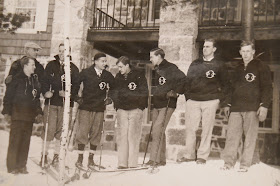 |
| The first snow sculpture, 1925 |
Winter Carnival, the brainchild of Fred Harris, 1911, founder of the Dartmouth College Outing Club, began as a series of sporting events designed to get students outdoors and clear away the winter doldrums. By the 1930s, Carnival had transformed into a series of parties, balls and contests (such as the crowning of the Queen of Snows) that had barely a passing connection to winter sports. Dartmouth men trapped in the woods of New Hampshire had turned it into the best excuse yet to invite women to campus.
National Geographic actually dubbed it the “Mardi Gras of the North.”
 |
| Waiting for dates to arrive on the Carnival Train |
 |
F. Scott Fitzgerald with Walter Wanger, 1915,
at Carnival in 1939 |
Following each Carnival, the Outing Club ran “Grief Meetings” where they detailed problems and issues in the vain hope of avoiding the same problems the following year. In 1933 they reported 2,848 people in attendance. By 1939, the year Budd Schulberg 1936, and F. Scott Fitzgerald showed up on campus with a film crew to create the movie “Winter Carnival,” the event had grown so big that
The Dartmouth reported, “Dartmouth must soon decide whether its largest social event of the year should be curtailed.” This did not come to pass, and Carnival went off again the following year with no apparent changes.
It took the outbreak of the Second World War to bring the tradition to its knees. Even then, it was not dead. Carnival was back and going strong again when the war ended. Now, 100 years after Fred Harris’s first modest ski contest, Carnival still thrives, albeit on a scale more in keeping with what the DOC wanted in 1939.
 |
| Winter Carnival Committee members, undated |




No comments:
Post a Comment